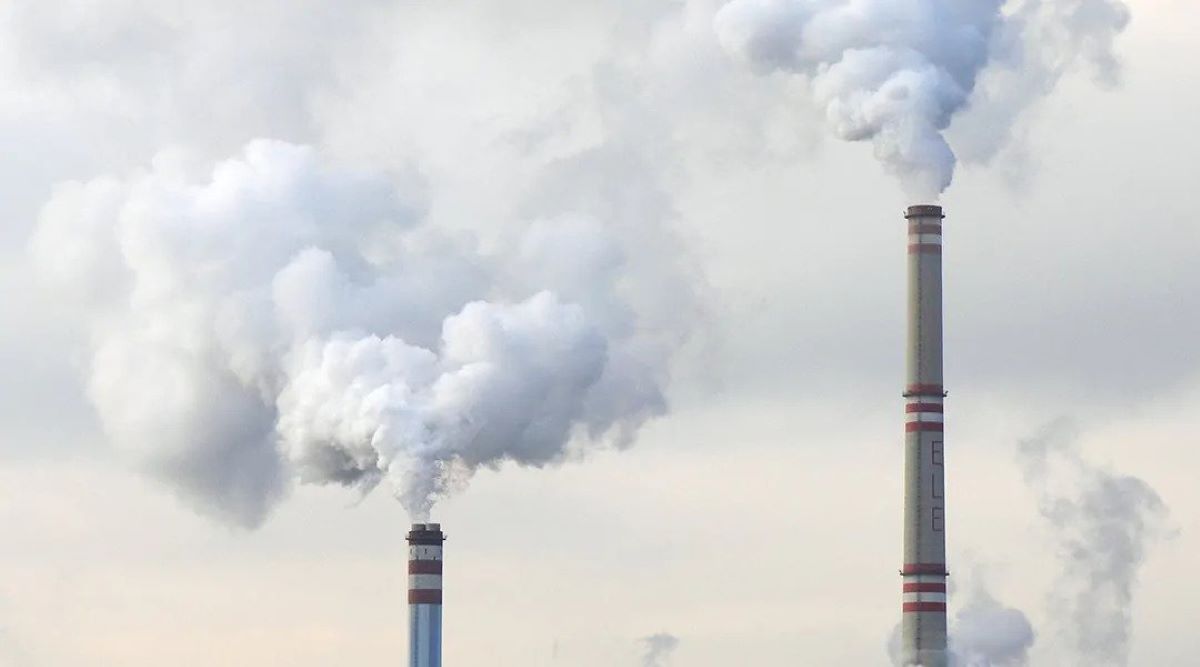Home>Gardening News and Trends>What Greenhouse Gas Is Most Abundant In The Atmosphere


Gardening News and Trends
What Greenhouse Gas Is Most Abundant In The Atmosphere
Modified: January 22, 2024
Discover the latest news on the most abundant greenhouse gas in the atmosphere. Stay informed and learn about its effects on climate change.
(Many of the links in this article redirect to a specific reviewed product. Your purchase of these products through affiliate links helps to generate commission for Chicagolandgardening.com, at no extra cost. Learn more)
Table of Contents
- Introduction
- Definition of Greenhouse Gases
- Importance of Greenhouse Gases in the Atmosphere
- Most Abundant Greenhouse Gas: Carbon Dioxide (CO2)
- Role of Carbon Dioxide in Climate Change
- Sources and Emissions of Carbon Dioxide
- Other Major Greenhouse Gases
- Methane (CH4)
- Nitrous Oxide (N2O)
- Fluorinated Gases (HFCs, PFCs, SF6, etc.)
- Conclusion
Introduction
Welcome to the world of greenhouse gases! Have you ever wondered about the invisible substances in our atmosphere that play a crucial role in regulating Earth’s temperature? These gases are known as greenhouse gases, and they have a significant impact on our climate system. Understanding the composition and abundance of greenhouse gases is vital for comprehending climate change and its implications for our planet and future generations.
Greenhouse gases are gases that trap heat from the Sun and prevent it from escaping back into space. These gases create what is known as the greenhouse effect, which is essential for maintaining a habitable temperature on Earth. Without greenhouse gases, our planet would be intolerably cold, with an average global temperature around minus 18 degrees Celsius (0 degrees Fahrenheit).
However, the issue arises when there is an excessive amount of these gases in the atmosphere. Human-induced activities, such as burning fossil fuels, deforestation, and industrial processes, have significantly increased the concentration of greenhouse gases. As a result, the Earth’s temperature is rising, leading to what we commonly refer to as climate change.
In this article, we will explore the most abundant greenhouse gas in the atmosphere and delve into its implications for climate change. We will also touch upon the other major greenhouse gases and their role in driving global warming. So, let’s dive into the fascinating world of greenhouse gases and unravel the mystery behind their prevalence in our atmosphere!
Definition of Greenhouse Gases
Before we delve into the specifics, let’s start by understanding what greenhouse gases actually are. Greenhouse gases are naturally occurring gases in the Earth’s atmosphere that have the ability to trap and radiate heat. These gases include carbon dioxide (CO2), methane (CH4), nitrous oxide (N2O), fluorinated gases (HFCs, PFCs, SF6), and others.
When sunlight reaches the Earth’s surface, some of the energy is absorbed and warms the planet. As the Earth radiates this heat back into space, greenhouse gases present in the atmosphere trap some of the heat, preventing it from escaping entirely. This phenomenon is similar to how a greenhouse operates. Sunlight enters through the glass walls, warming the interior, but the heat struggles to escape, resulting in higher temperatures.
This natural greenhouse effect is essential for sustaining life on Earth as it maintains a relatively stable climate. However, human activities have significantly increased the concentration of these gases in the atmosphere, leading to an enhanced greenhouse effect and resulting in global warming and climate change.
It’s important to note that not all gases contribute equally to the greenhouse effect. Some gases have a stronger heat-trapping potential than others. Additionally, the amount of time each gas can remain in the atmosphere varies, impacting the duration and intensity of their effect on temperature.
Now that we have established the definition of greenhouse gases and their role in regulating Earth’s temperature, let’s dive deeper into the most abundant greenhouse gas found in the atmosphere and its impact on climate change.
Importance of Greenhouse Gases in the Atmosphere
Greenhouse gases play a crucial role in the Earth’s atmosphere, maintaining a delicate balance that allows life to thrive. Without these gases, our planet would be a cold and uninhabitable place. Let’s explore the importance of greenhouse gases in more detail:
1. Regulation of Earth’s Temperature: Greenhouse gases act as a natural blanket, trapping heat from the Sun and preventing it from escaping back to space. This process creates a balance by keeping the Earth’s average temperature at a comfortable level, allowing for the existence of liquid water, which is essential for life.
2. Maintenance of Climate Stability: By controlling the amount of heat retained in the atmosphere, greenhouse gases help maintain climate stability. They prevent extreme temperature fluctuations, protecting ecosystems and supporting the complex web of life on Earth.
3. Support for Photosynthesis: Some greenhouse gases, such as carbon dioxide, are vital for photosynthesis, the process by which plants convert sunlight, water, and carbon dioxide into energy. This process not only supports plant growth and survival but also produces oxygen, which is crucial for the survival of all living organisms.
4. Influence on Weather Patterns: Greenhouse gases have a direct impact on weather patterns and the distribution of precipitation. Changes in their concentration can result in shifts in rainfall patterns, increased frequency and intensity of extreme weather events, and alterations in climate zones.
5. Ecological Balance: Greenhouse gases play a significant role in maintaining ecological balance by influencing the geographical distribution of plant and animal species. Changes in greenhouse gas levels can lead to shifts in ecosystems and impact biodiversity, with potential consequences for the entire food chain.
While greenhouse gases are critical for the functioning of Earth’s climate system, human activities have disrupted this delicate balance. The excessive emission of greenhouse gases, primarily from the burning of fossil fuels, deforestation, and industrial processes, has led to an increase in their concentration in the atmosphere.
In the next section, we will explore the most abundant greenhouse gas in the atmosphere and discuss its role in climate change.
Most Abundant Greenhouse Gas: Carbon Dioxide (CO2)
When it comes to the most abundant greenhouse gas in the atmosphere, carbon dioxide (CO2) takes the crown. It is a colorless and odorless gas naturally present in the Earth’s atmosphere at relatively low concentrations. However, human activities, particularly the burning of fossil fuels such as coal, oil, and natural gas, have significantly increased its levels in recent centuries.
Carbon dioxide is a crucial component of the carbon cycle, a natural process that helps maintain the Earth’s temperature. Plants absorb carbon dioxide during photosynthesis, converting it into oxygen and carbohydrates. This absorption helps regulate the concentration of carbon dioxide in the atmosphere.
Unfortunately, human activities have disrupted this balance by releasing large amounts of carbon dioxide into the atmosphere. This excess carbon dioxide traps more heat, contributing to the greenhouse effect and leading to global warming.
The burning of fossil fuels for electricity, transportation, and industrial processes is the main source of carbon dioxide emissions. Deforestation, which reduces the Earth’s capacity to absorb carbon dioxide through photosynthesis, is another significant contributor. Additionally, certain industrial processes and chemical reactions also release carbon dioxide into the atmosphere.
The consequences of increased carbon dioxide levels are far-reaching. Rising global temperatures, melting glaciers, sea-level rise, and changes in precipitation patterns are just a few of the impacts associated with the accumulation of carbon dioxide in the atmosphere.
Efforts to mitigate the effects of carbon dioxide emissions include transitioning to renewable energy sources, improving energy efficiency, and implementing carbon capture and storage technologies. These actions aim to reduce carbon dioxide emissions and stabilize its concentration in the atmosphere.
While carbon dioxide is the most abundant greenhouse gas, it is not the only greenhouse gas contributing to climate change. In the following sections, we will explore other major greenhouse gases and their roles in the complex climate system.
Role of Carbon Dioxide in Climate Change
Carbon dioxide (CO2) plays a significant role in driving climate change due to its potent greenhouse effect. As the most abundant greenhouse gas in the Earth’s atmosphere, carbon dioxide contributes to the trapping of heat, leading to a rise in global temperatures. Let’s explore the role of carbon dioxide in climate change in more detail:
1. Greenhouse Effect: Carbon dioxide and other greenhouse gases act like a blanket around the Earth, trapping heat and preventing it from escaping into space. This natural greenhouse effect is vital for sustaining a habitable temperature on our planet. However, human activities have caused a significant increase in carbon dioxide concentrations, enhancing the greenhouse effect and leading to global warming.
2. Historical Levels and Recent Rise: While carbon dioxide has always been present in the atmosphere, its concentrations have been relatively stable over thousands of years. However, since the Industrial Revolution, human activities, particularly the burning of fossil fuels, have significantly accelerated carbon dioxide emissions. As a result, atmospheric carbon dioxide levels have risen from around 280 parts per million (ppm) in pre-industrial times to over 415 ppm in 2021 – the highest in at least 800,000 years.
3. Temperature Increase: The increase in carbon dioxide levels has contributed to a rise in global temperatures. The Intergovernmental Panel on Climate Change (IPCC) has concluded that human activities are responsible for most of the observed global warming since the mid-20th century. This temperature increase has resulted in numerous impacts, including heatwaves, extreme weather events, melting of ice caps and glaciers, and changes in precipitation patterns.
4. Ocean Acidification: Excess carbon dioxide not only affects the atmosphere but also has profound consequences for the world’s oceans. When carbon dioxide is absorbed by seawater, it undergoes a chemical reaction that lowers the pH, resulting in ocean acidification. This acidification poses a threat to marine ecosystems, including coral reefs, shellfish, and other marine organisms that rely on calcium carbonate to build their shells and skeletons.
5. Feedback Loops: The rise in temperatures due to increased carbon dioxide levels can trigger feedback loops that further accelerate climate change. For example, as temperatures increase, permafrost in Arctic regions may thaw, releasing large amounts of methane, another potent greenhouse gas. This release of methane can contribute to additional warming and create a feedback loop that amplifies the effects of climate change.
Reducing carbon dioxide emissions is crucial for mitigating climate change and its impacts. Transitioning to renewable energy sources, increasing energy efficiency, and adopting sustainable land-use practices are among the strategies employed to curb carbon dioxide emissions. Collectively, these efforts aim to stabilize carbon dioxide levels in the atmosphere and limit the extent of future global warming.
In the following sections, we will explore other major greenhouse gases and their impact on climate change.
Sources and Emissions of Carbon Dioxide
The sources of carbon dioxide (CO2) emissions are diverse and span across various sectors of human activity. Understanding these sources is essential for developing effective strategies to mitigate carbon dioxide emissions and combat climate change. Let’s explore the primary sources of carbon dioxide emissions:
1. Fossil Fuel Combustion: The burning of fossil fuels for electricity generation, transportation, and industrial processes is the largest contributor to carbon dioxide emissions. Power plants that rely on coal, oil, and natural gas release significant amounts of carbon dioxide when these fuels are burned to produce energy. Similarly, vehicles powered by internal combustion engines emit carbon dioxide as a byproduct of fuel combustion.
2. Deforestation and Land Use Changes: Deforestation, the clearing of forests for agriculture, urbanization, and other purposes, contributes to carbon dioxide emissions. Trees act as carbon sinks, absorbing carbon dioxide through photosynthesis. When forests are cleared, the stored carbon is released back into the atmosphere as carbon dioxide. Land use changes, such as converting forests into agricultural land, also contribute to carbon dioxide emissions.
3. Industrial Processes: Certain industrial processes, such as cement production, steel manufacturing, and chemical production, release carbon dioxide as a byproduct. These processes often involve the use of high-temperature kilns and chemical reactions that result in the release of carbon dioxide into the atmosphere.
4. Waste and Biomass Burning: The decomposition of organic waste in landfills produces carbon dioxide emissions. Additionally, the burning of biomass, such as agricultural waste and wood, releases carbon dioxide. While biomass burning is considered carbon-neutral in the long term if done sustainably, when it occurs at an extensive scale or is not managed properly, it can contribute to carbon dioxide emissions.
5. Natural Processes: While human activities are the primary drivers of increased carbon dioxide emissions, natural processes also contribute to the carbon cycle. For example, volcanic activity and wildfires release carbon dioxide into the atmosphere. However, these natural emissions are relatively small compared to human-caused emissions.
Addressing carbon dioxide emissions requires a multi-pronged approach. Transitioning to cleaner energy sources, such as renewable energy, can reduce carbon dioxide emissions from fossil fuel combustion. Implementing sustainable land management practices and protecting forests can help prevent deforestation and promote carbon sequestration. Additionally, improving industrial processes and waste management can reduce carbon dioxide emissions from these sectors.
It is worth noting that carbon dioxide emissions can vary significantly between countries and regions due to differing levels of industrialization, energy sources, and land-use practices. International efforts to mitigate emissions, such as the Paris Agreement, aim to coordinate global action and reduce carbon dioxide emissions to combat climate change on a global scale.
In the next sections, we will explore other significant greenhouse gases and their sources, expanding our understanding of their contributions to climate change.
Other Major Greenhouse Gases
While carbon dioxide (CO2) is the most abundant greenhouse gas, there are several other significant greenhouse gases that contribute to climate change. These gases have varying levels of potency in terms of their heat-trapping potential and atmospheric lifetimes. Let’s explore some of the other major greenhouse gases:
1. Methane (CH4): Methane is the second most abundant greenhouse gas and is approximately 25 times more potent than carbon dioxide in terms of its heat-trapping ability. Methane is emitted through both natural processes and human activities. Natural sources include wetlands, termites, and the digestive systems of ruminant animals. Human-caused emissions come from activities such as agriculture (rice cultivation and livestock), fossil fuel production and distribution, and the decomposition of organic waste in landfills.
2. Nitrous Oxide (N2O): Nitrous oxide is released through both natural and human activities. It has a warming potential almost 300 times greater than carbon dioxide. Natural sources of nitrous oxide include oceans, soils, and nitrogen-rich plants. Human activities that contribute to nitrous oxide emissions include agricultural and industrial activities, combustion of fossil fuels, and the use of nitrogen-based fertilizers.
3. Fluorinated Gases (HFCs, PFCs, SF6, etc.): Fluorinated gases are synthetic compounds produced for various industrial purposes. HFCs (hydrofluorocarbons) are commonly used as refrigerants and in air conditioning systems. PFCs (perfluorocarbons) are used in the production of aluminum, semiconductor manufacturing, and electronics. These gases have high global warming potentials and can stay in the atmosphere for long periods. SF6 (sulfur hexafluoride) is another fluorinated gas used in electrical equipment and has an extremely high warming potential.
While these greenhouse gases may be less abundant in the atmosphere compared to carbon dioxide, their potency and persistence contribute significantly to climate change. It’s important to note that reducing emissions of these gases can have a substantial impact on mitigating global warming.
Efforts to reduce methane emissions include improving agricultural practices, such as better livestock management and manure management systems. Additionally, reducing fossil fuel production and distribution leaks, as well as minimizing methane emissions from waste management, can help combat climate change.
For nitrous oxide, implementing more efficient agricultural practices, optimizing the use of nitrogen-based fertilizers, and reducing emissions from industrial processes are key strategies. Transitioning away from the use of fluorinated gases in various industries and adopting alternative, more climate-friendly technologies and refrigerants can significantly reduce their impact on global warming.
Understanding the sources and impact of these other major greenhouse gases is crucial for developing comprehensive strategies to address climate change. The collective efforts to mitigate emissions of all major greenhouse gases are vital for slowing down global warming and protecting the health and sustainability of our planet.
Next, we will conclude with a summary of the key points discussed in this article.
Methane (CH4)
Methane (CH4) is a potent greenhouse gas that plays a significant role in climate change. While carbon dioxide (CO2) is the most abundant greenhouse gas, methane has a much higher warming potential. Let’s explore methane in more detail:
Sources of Methane: Methane is emitted through both natural processes and human activities. Natural sources include wetlands, where methane is produced as organic matter decomposes in oxygen-deprived conditions. Termites also release methane through their digestive processes. Additionally, natural gas deposits, permafrost regions, and ocean sediments contribute to methane emissions.
Human-Induced Methane Emissions: Human activities are a major contributor to methane emissions. Agriculture is one significant source, with livestock such as cattle and sheep producing methane during digestion through a process called enteric fermentation. Rice cultivation in flooded fields also generates methane through microbial processes. Another significant source is the decomposition of organic waste in landfills. Additionally, methane is released during the extraction, production, and distribution of coal, oil, and natural gas.
Impact on Climate Change: Methane has a much higher warming potential compared to carbon dioxide, with roughly 25 times the heat-trapping capability over a 100-year period. While methane remains in the atmosphere for a shorter time compared to carbon dioxide, it is more efficient at trapping heat during its presence. Methane concentrations have risen significantly since pre-industrial times, primarily due to human activities.
Consequences of Methane Emissions: The increase in methane emissions contributes to global warming and its associated impacts. Methane is responsible for about 20% of global warming since the pre-industrial era. Rising temperatures due to methane emissions can lead to the melting of permafrost, which further releases stored methane, creating a feedback loop that amplifies climate change. Additionally, the warming effect of methane contributes to the rapid melting of ice caps, leading to sea-level rise.
Mitigating Methane Emissions: Reducing methane emissions is crucial for addressing climate change. Strategies to mitigate methane emissions include improving livestock management practices, such as modifying animal diets and capturing methane from manure. Implementing more efficient rice cultivation techniques, such as alternate wetting and drying, can also reduce methane emissions. Minimizing methane leakage during the extraction, production, and distribution of fossil fuels is another important focus. Furthermore, capturing methane from landfills and using it as an energy source can help reduce emissions.
Efforts to reduce methane emissions are not only beneficial for addressing climate change but also for improving air quality and public health, as methane is a potent pollutant. The implementation of methane reduction strategies requires collaboration and coordinated actions from governments, industries, and individuals.
By understanding the sources of methane emissions and implementing effective mitigation measures, we can make significant strides in combating climate change and working towards a more sustainable future.
In the following section, we will discuss another significant greenhouse gas, nitrous oxide (N2O), and its impact on climate change.
Nitrous Oxide (N2O)
Nitrous oxide (N2O) is a powerful greenhouse gas that contributes to climate change. While it may not be as abundant as carbon dioxide (CO2), it has a much higher warming potential. Let’s explore nitrous oxide in more detail:
Sources of Nitrous Oxide: Nitrous oxide is emitted through natural processes and human activities. Natural sources include oceans, soils, and nitrogen-rich plants. Bacteria naturally produce nitrous oxide during processes such as nitrification and denitrification. Human activities, particularly those related to agricultural and industrial practices, contribute significantly to nitrous oxide emissions.
Agricultural Practices: Agriculture is a major source of nitrous oxide emissions. The use of nitrogen-based fertilizers, such as nitrogen-containing synthetic fertilizers and animal manure, enhances crop productivity but also contributes to nitrous oxide emissions. Poor management of fertilizer application can lead to excess nitrogen in soils, which can be converted into nitrous oxide by soil bacteria.
Industrial Activities: Industrial processes, especially those involving the combustion of fossil fuels and solid waste, contribute to nitrous oxide emissions. Chemical production, such as the production of nitric acid and adipic acid, also releases nitrous oxide into the atmosphere. Additionally, the use of nitrogen-based compounds in industries such as rubber manufacturing and fireworks production can lead to nitrous oxide emissions.
Impact on Climate Change: Nitrous oxide has a much higher warming potential compared to carbon dioxide, with approximately 300 times the heat-trapping capacity over a 100-year period. Nitrous oxide is responsible for about 6% of the total greenhouse effect. Its long atmospheric lifetime of around 114 years allows it to accumulate and contribute to climate change over an extended period.
Consequences of Nitrous Oxide Emissions: The increase in nitrous oxide emissions contributes to global warming and its associated impacts. Nitrous oxide contributes to the destruction of the ozone layer and acts as a catalyst in the production of other greenhouse gases, including tropospheric ozone, which is a potent greenhouse gas and air pollutant. Additionally, nitrous oxide contributes to the acidification of soils and water bodies, which can impact ecosystem health and biodiversity.
Mitigating Nitrous Oxide Emissions: Reducing nitrous oxide emissions requires implementing sustainable agricultural practices and improving industrial processes. Practices such as precision agriculture, which involves optimizing fertilizer use based on crop needs, can help minimize nitrogen runoff and subsequent nitrous oxide emissions. Crop rotation and diversification can also enhance nitrogen fixation by plants and reduce the need for nitrogen fertilizers. In industries, implementing technologies and processes to capture and reduce nitrous oxide emissions can contribute to emission reductions.
Efforts to mitigate nitrous oxide emissions not only help address climate change but also lead to co-benefits such as improved soil health, water quality, and agricultural productivity. Collaboration between governments, farmers, industries, and researchers is essential to develop and implement effective strategies for reducing nitrous oxide emissions.
In the next section, we will explore another class of significant greenhouse gases, fluorinated gases, and their impact on climate change.
Fluorinated Gases (HFCs, PFCs, SF6, etc.)
Fluorinated gases are a group of synthetic compounds that are commonly used in various industrial applications. These gases, including hydrofluorocarbons (HFCs), perfluorocarbons (PFCs), and sulfur hexafluoride (SF6), have high global warming potentials and significantly contribute to climate change. Let’s explore fluorinated gases in more detail:
Hydrofluorocarbons (HFCs): HFCs are commonly used as refrigerants and in air conditioning, heating, and insulation systems. They were introduced as alternatives to chlorofluorocarbons (CFCs) and hydrochlorofluorocarbons (HCFCs), which have ozone-depleting properties. While HFCs do not harm the ozone layer, they have a high global warming potential, making them potent greenhouse gases.
Perfluorocarbons (PFCs): PFCs are primarily used in industries, such as electronic manufacturing, semiconductor production, and the manufacturing of aluminum. They have a wide range of applications due to their unique properties, including good heat resistance and electrical insulation. PFCs have significantly high global warming potentials and can persist in the atmosphere for long periods, contributing to climate change.
Sulfur Hexafluoride (SF6): SF6 is mainly used in electrical equipment, such as circuit breakers, switches, and transformers, as an electrical insulator and arc quencher. It is known for its excellent insulating properties and high electrical conductivity. SF6 has an extremely high global warming potential and can persist in the atmosphere for thousands of years.
Fluorinated gases are synthetic compounds that do not occur naturally in the environment. Their global warming potentials vary significantly, with some being several thousand times more potent than carbon dioxide. Although their concentrations in the atmosphere are relatively low compared to carbon dioxide, their heat-trapping abilities make them significant contributors to climate change.
Reducing fluorinated gas emissions is essential for mitigating climate change. Efforts to address these emissions include the adoption of alternative technologies and more climate-friendly substitutes. For example, transitioning to low-global-warming-potential refrigerants in air conditioning and refrigeration systems can significantly reduce HFC emissions.
International agreements, such as the Kigali Amendment to the Montreal Protocol, aim to phase down and ultimately phase out the production and use of HFCs. The amendment aims to limit global warming by reducing the use of these potent greenhouse gases in various sectors.
Proper management and disposal of electrical equipment containing SF6 can also contribute to emissions reduction. Improving industrial processes and adopting technologies that prevent or capture PFC emissions is another important step.
As fluorinated gases are entirely human-made, their emission levels can be controlled through conscious efforts and the use of alternative substances with lower global warming potentials. By reducing the emissions of these gases, we can significantly reduce their impact on climate change and work towards a more sustainable future.
In the final section of this article, we will briefly summarize the key points discussed and emphasize the importance of collective actions to address greenhouse gas emissions and combat climate change.
Conclusion
Greenhouse gases are an integral part of Earth’s atmosphere, regulating its temperature and supporting the conditions necessary for life to thrive. However, human activities have significantly disrupted this balance by releasing excessive amounts of greenhouse gases into the atmosphere, leading to climate change. In this article, we explored the key aspects of greenhouse gases, focusing on the most abundant ones and their impact on our planet.
Carbon dioxide (CO2) is the predominant greenhouse gas, primarily stemming from the burning of fossil fuels and deforestation. Its role in climate change is undeniable, as it contributes to the greenhouse effect and global warming. We also explored the importance of mitigating carbon dioxide emissions through sustainable energy practices, improving efficiency, and adopting carbon capture technologies.
Additionally, we discussed other major greenhouse gases, such as methane (CH4), nitrous oxide (N2O), and fluorinated gases (HFCs, PFCs, SF6). These gases, although less abundant than carbon dioxide, have higher warming potentials and significantly contribute to global warming. We highlighted the sources, impact, and mitigation strategies for each of these gases.
It is crucial to acknowledge that addressing climate change requires collective action and a multi-faceted approach. Governments, industries, communities, and individuals must work together to reduce greenhouse gas emissions. Transitioning to renewable energy sources, implementing sustainable agricultural practices, improving industrial processes, and promoting responsible waste management are among the key steps needed to mitigate the impacts of greenhouse gases.
While the challenges posed by climate change are daunting, the actions we take today can make a significant difference in shaping the future of our planet. By collectively reducing greenhouse gas emissions, we can work towards stabilizing the climate, preserving ecosystems, and ensuring a sustainable future for generations to come.
Let us embrace the urgency of this issue and embark on a path towards a greener, more resilient world.







